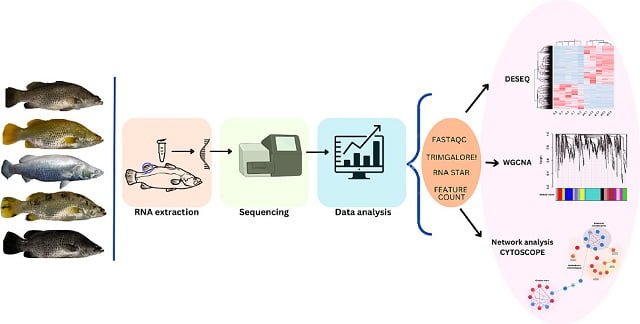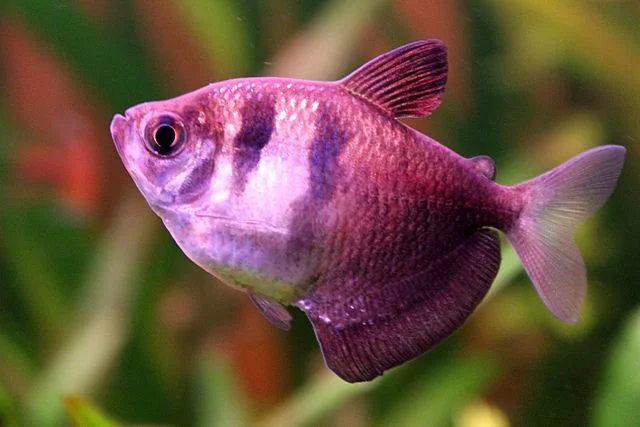
The Barramundi, a fish highly valued in aquaculture, comes in a surprising variety of colors. Beyond the standard silver or bronze, rare variations such as gold, platinum, panda (gold and black), and even black have been observed. These vibrant hues have significant commercial value, but the underlying genetics remain a mystery.
A new study published in the journal Aquaculture sheds light on the molecular mechanisms that give these barramundi (Lates calcarifer) such dazzling colors. Researchers from James Cook University and Mainstream Aquaculture compared the genes expressed in fish of different colors with those of the standard silver type. They identified numerous genes with different levels of activity depending on the color of the fish.
The Enigma of Barramundi Coloration
The barramundi exhibits a range of colors in its rare variants. While the wild type has silver/bronze skin, some individuals surprise with stunning shades of gold, platinum, panda (gold and black), and even black. Interestingly, these vibrant hues are not set in stone: fish develop their unique colors later in life, and stress or environmental changes can even trigger a transformation!
Scientists already know that the number, distribution, and location of chromatophores define a fish’s color. In barramundi, the presence and amount of mature melanophores appear to be the key players in creating the observed color variations. However, the exact genetic instructions behind these changes have remained elusive.
Unlocking the Genetic Code of Color
Researchers have already unraveled the molecular pathways for pigment production in fish, particularly for melanin- and carotenoid-based colors. This study builds on this knowledge by analyzing the genetic composition (transcriptome) of barramundi with different color variations. This comparison aims to identify the genes and molecular mechanisms responsible for these rare and captivating phenotypes.
By understanding the genetic code of color, researchers hope to uncover the secrets behind barramundi’s hidden hues. This knowledge could enhance selective breeding practices in aquaculture, allowing the cultivation of barramundi with specific colorations that meet consumer preferences and maximize commercial value.
A Network of Color Control
The analysis revealed a network of genes working together to influence color. Interestingly, some of these genes are involved in the body’s natural rhythm (circadian cycle), while others manage the production of melanin (the pigment responsible for dark colors) and a type of cell called xanthophore (which creates yellow and red pigments). These findings suggest a complex interaction between internal biological processes and pigment production.
Moreover, the study revealed that the genes in pigment-producing cells in golden and platinum barramundi lacked the ability to produce melanin and other pigments, resulting in the rare colorations of this iconic fish. Their analysis revealed:
Stay Always Informed
Join our communities to instantly receive the most important news, reports, and analysis from the aquaculture industry.
- Multiple Genes at Play: The study identified numerous genes with different levels of activity (differentially expressed genes) between the color forms. This suggests a complex interaction of genes, not a simple switch controlling color.
- Color Coordination Network: Beyond individual genes, researchers identified 14 groups of genes working together to regulate skin coloration. These modules included genes involved in the body’s internal clock (circadian cycle), melanin production (melanogenesis), and pigment cell development (xanthophores).
- Confirmed Golden Gene: Focusing on golden barramundi, the study identified a specific gene (oca2) as a key player. This gene interacts with other genes that control the circadian cycle, melanin production, and pigment cells, suggesting its crucial role in creating the golden hue.
“Without the black and silver melanin tint in the skin, the other pigment cells producing yellow and gold colors make the fish look golden,” said Professor Dean Jerry, co-author of the study and director of the ARC Research Hub for Supercharging Tropical Aquaculture through Genetic Solutions at James Cook University.
Professor Jerry said that the flesh of golden barramundi had a lighter and whiter appearance compared to the grayer flesh of a normal barramundi.
- Platinum Puzzle Pieces: For platinum barramundi, scientists identified potential candidate genes: myo5aa, mlpha, and kif5b. These genes could be responsible for regulating pigment transporters, influencing the distribution of melanin, carotenoids, and pteridines (pigment molecules). Further research is needed to confirm their exact role in achieving the platinum color.
According to Jerry, “In the case of the platinum fish, it seems as if both the melanin and yellow pigment cells cease to produce pigments, leaving the fish with a white/platinum color.”
Conclusion
Professor Jerry said that now that the genes contributing to producing a golden barramundi have been understood, the team can look within those genes to identify fish with the desired genetic variation and thus enhance Mainstream Aquaculture’s ability to selectively breed them.
Dr. Paul Harrison of Mainstream Aquaculture said that the company was “pleased to work on developing this product with researchers from James Cook University.”
“Bringing a new product like this to market requires a lot of work involving a combination of science, selective breeding, and investment in commercialization,” he said.
“Mainstream has built specialized facilities for this unique breeding line and has developed a large cohort of breeders. Unlocking the process of color regulation control will provide a new barramundi product to consumers.”
By understanding the genes controlling barramundi coloration, researchers can potentially develop breeding programs to produce fish with desired colors. This could be a significant boost for aquaculture, allowing farmers to meet specific market demands for vibrant fish. The study also opens the door to further exploration of color variation in other fish species, paving the way for a more colorful and diverse aquaculture industry.
The study was funded by the Australian Research Council (ARC).
Contact
R. Marcoli
ARC Research Hub for Supercharging Tropical Aquaculture through Genetic Solutions, James Cook University
Townsville, QLD, Australia.
Email: roberta.marcoli@jcu.edu.au
Reference (open access)
Marcoli, R., Jones, D., Massault, C., Moran, M., Harrison, P., Cate, H., & Jerry, D. (2024). Revealing the genetic and molecular drivers behind golden and platinum coloration in barramundi (Lates calcarifer). Aquaculture, 586, 740820. https://doi.org/10.1016/j.aquaculture.2024.740820
Note: Prepared with information from the press release and the study.
Editor at the digital magazine AquaHoy. He holds a degree in Aquaculture Biology from the National University of Santa (UNS) and a Master’s degree in Science and Innovation Management from the Polytechnic University of Valencia, with postgraduate diplomas in Business Innovation and Innovation Management. He possesses extensive experience in the aquaculture and fisheries sector, having led the Fisheries Innovation Unit of the National Program for Innovation in Fisheries and Aquaculture (PNIPA). He has served as a senior consultant in technology watch, an innovation project formulator and advisor, and a lecturer at UNS. He is a member of the Peruvian College of Biologists and was recognized by the World Aquaculture Society (WAS) in 2016 for his contribution to aquaculture.




